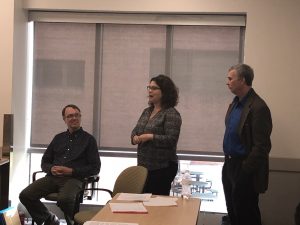Formally launched in 2015 and adapted from the University of Michigan’s foundational STRIDE model, UMBC – STRIDE embraces a peer to peer education model in which highly respected faculty serve as STRIDE fellows who work withintheir communities to raise awareness about implicit biases and strategize best practices for recruiting and retaining a diverse and inclusively excellent professoriate.
Mission
Our goal is facilitate conversations with our faculty peers on ways in which we can collectively work together and implement actions that recruit, retain, and advance a critically diverse and inclusively excellent faculty.
Our Shared Approach: Critical Diversity and Social Justice
UMBC – STRIDE works within the framework of critical diversity (Henderson and Herring, 2013). Critical diversity can be defined as “the  equal inclusion of people from varied backgrounds on a parity basis throughout all ranks and division of [an] organization. It especially refers to inclusion of those who are considered to be different from traditional members because of exclusionary practices (300).” This critical approach allows STRIDE to recognize diversity as multidimensional and intersectional and grounded within a context-specific historical framework.The critical diversity perspective facilitates a historical and context-specific approach through a disaggregation of the macro university to reveal underrepresentation at the meso level of colleges, and more micro levels of departments, disciplines, and sub-disciplines. UMBC – STRIDE also situates diversity and inclusive excellence in higher education within a social justiceparadigm (Byrd, 2014).
equal inclusion of people from varied backgrounds on a parity basis throughout all ranks and division of [an] organization. It especially refers to inclusion of those who are considered to be different from traditional members because of exclusionary practices (300).” This critical approach allows STRIDE to recognize diversity as multidimensional and intersectional and grounded within a context-specific historical framework.The critical diversity perspective facilitates a historical and context-specific approach through a disaggregation of the macro university to reveal underrepresentation at the meso level of colleges, and more micro levels of departments, disciplines, and sub-disciplines. UMBC – STRIDE also situates diversity and inclusive excellence in higher education within a social justiceparadigm (Byrd, 2014).
Byrd, M.Y. (2014). “Re-conceptualizing and re-visioning diversity in the workforce: Toward a social justice paradigm.” In Byrd, M.Y. and Scott, C.L. (Eds.), Diversity in the workforce: Current issues and emerging trends, (334-346). New York: Routledge.
Henderson, L. and Herring, C. (2013). “Does critical diversity pay in higher education? Race, gender, and departmental rankings in research universities.” Politics, Groups, and Identities, 1(3), 299-310.
